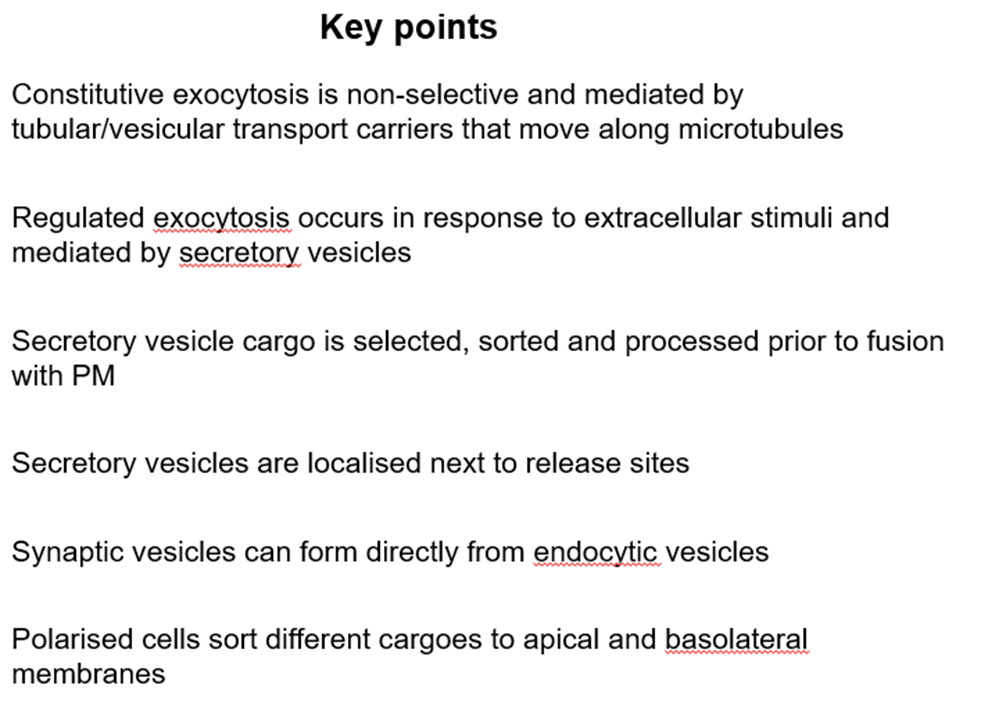Week 11 L1 P2 - Exocytosis
1/30
There's no tags or description
Looks like no tags are added yet.
Name | Mastery | Learn | Test | Matching | Spaced |
|---|
No study sessions yet.
31 Terms
What are the different destinations for cargo at the TGN?
o Cargo without signals is delivered to the plasma membrane by ‘default’-constitutive secretion
o Cargo with mannose- 6 -phosphate will go to lysosomes
o Other proteins will be packaged into secretory vesicles for regulated exocytosis

What are the 2 types of secretion?
Constitutive and regulated
What is constitutive secretion?
o Constant stream of transport containers moves from the TGN to the plasma membrane (PM) => constitutive exocytosis
o No specific control of the process
What does constitutive secretion supply the PM with?
new protein and lipid made in the ER allowing:
1.) PM expansion before cell division
2.) Protein secretion
What are the transport containers for constitutive secretion?
Vesicular or tubular in nature
Formed by motor-driven extrusion of TGN along microtubules
Move along microtubules and fuse with PM
Extrusion and movement requires kinesin (MT + end motor)
No coat protein identified: consistent with no selection of cargo
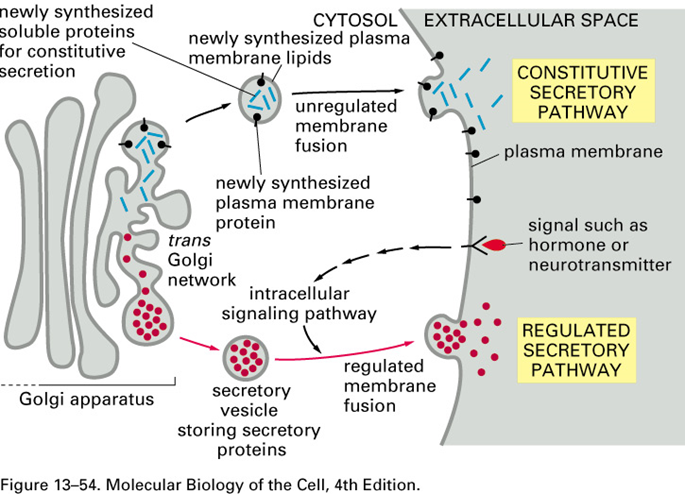
What is the regulated secretion pathway?
o Specialised secretory cells make hormones, neurotransmitters, enzymes => sorted into secretory vesicles that bud from TGN and accumulate near the PM.
o Only fuse with PM and release content after stimulation by extracellular signal
o e.g. Blood [glucose] increase, sensed be pancreas, depolarisation, so insulin secretion increases
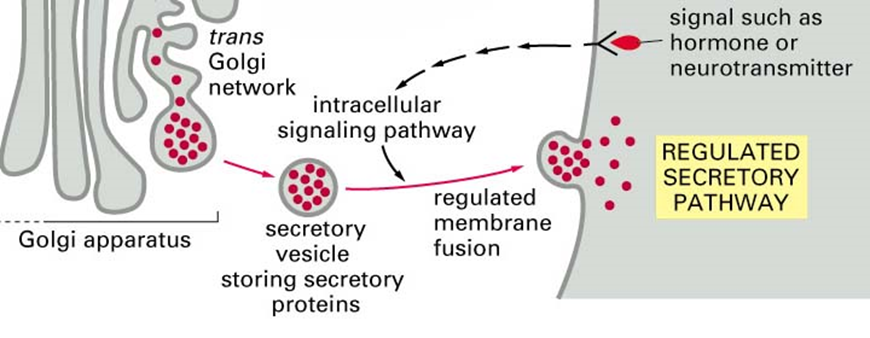
Why is there selective aggregation of secretory proteins?
Cargo have hydrophobic patches on membrane and aggregation is probably mediated by a signal patch on proteins
Allows a high concentration to gather in a region of the trans golgi network
Aggregates sorted into vesicles
Sorting mechanism not known
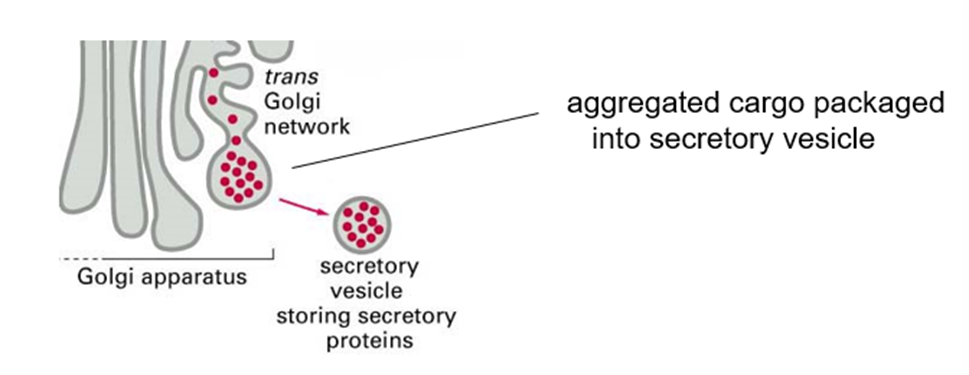
How are secretory vesicles matured?
Secreted cargo is aggregated in the lumen of vesicle
Membranes are retrieved from the immature secretory vesicle and recycled back to the TGN driven by clathrin coated vesicles
Concentrate cargo
Maturation => cargo concentration
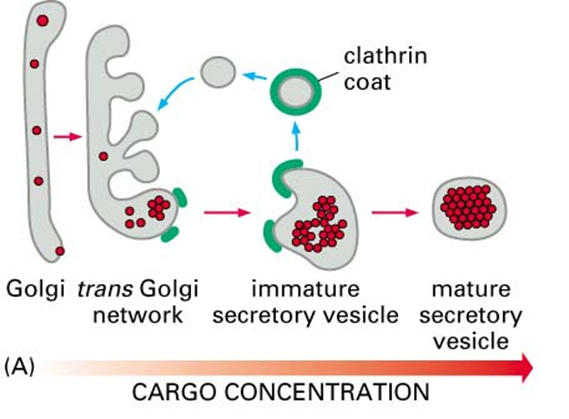
What causes an increase in cargo concentration?
o 1.) Retrieval of membrane in clathrin coated vesicles
o 2.) Acidification of lumen by ATP-driven H+ pumps (further promotes aggregation)
What does dense packing allow?
rapid release of large amounts of material
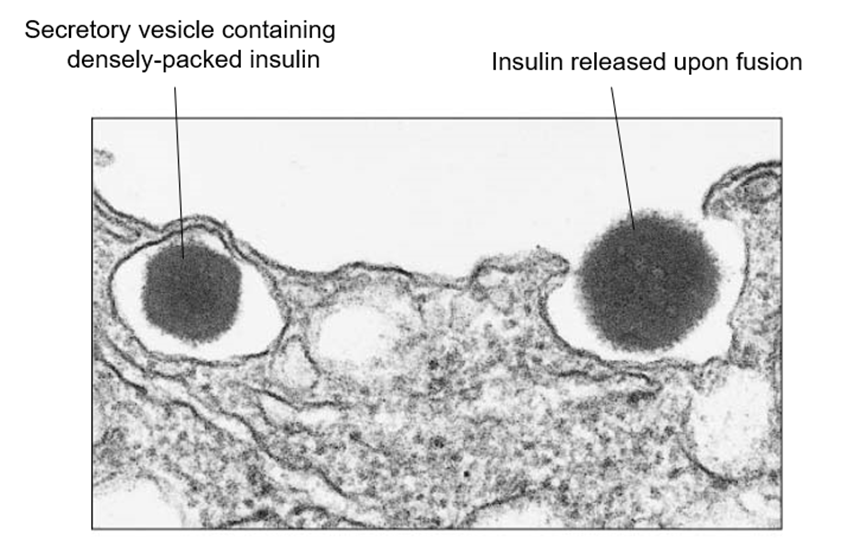
How are many polypeptide hormones, peptides and digestive enzymes made?
As inactive protein precursors and then proteolysed to release active molecules
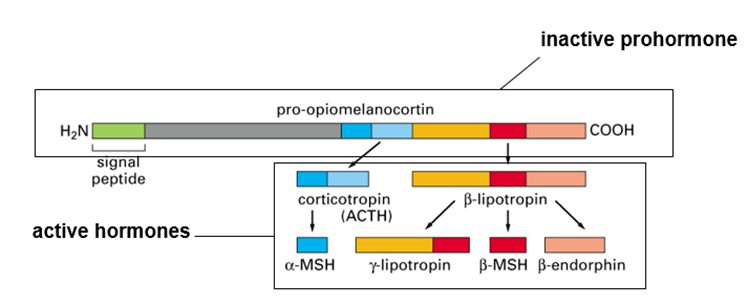
Why are they inactive?
Peptides too small for ER targeting (Need signal signal for secretory pathway )
Don’t want active products until release e.g. digestive enzymes
What do secretory vesicles do?
They wait near the PM until there is a signal to fuse
eg neurons
Synaptic vesicles accumulate near release site in synaptic cleft
Active zone = where the presynaptic cells meets the post synaptic cell
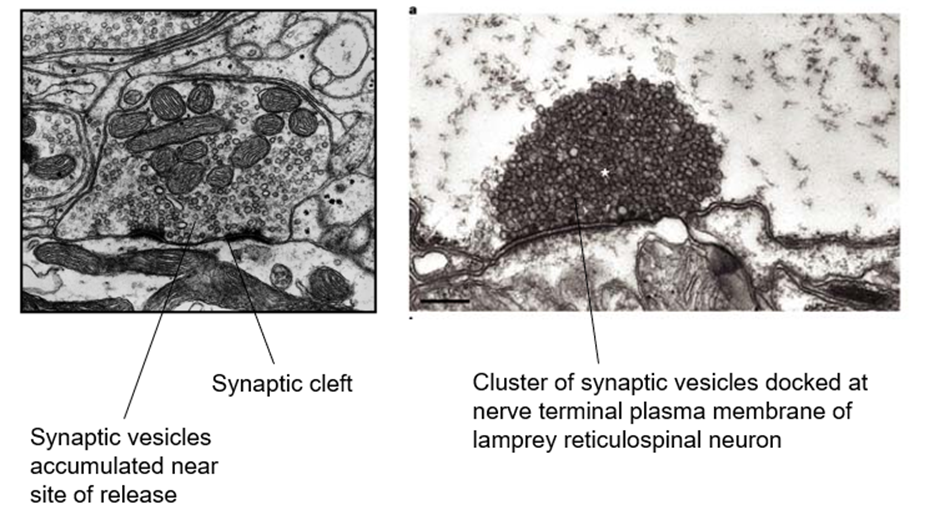
What are synaptic vesicles?
store small neurotransmitter molecules, such as acetylcholine, glutamate, glycine, and γ-aminobutyric acid (GABA), which mediate rapid signaling from a nerve cell to its target cell at chemical synapses
What happens at nerve cells?
When an action potential arrives at a nerve terminal, it causes an influx of Ca2+ through voltage-gated Ca2+ channels, which triggers the synaptic vesicles to fuse with the plasma membrane and release their contents to the extracellular space
Some neurons fire more than 1000 times per second, releasing neurotransmitters each time
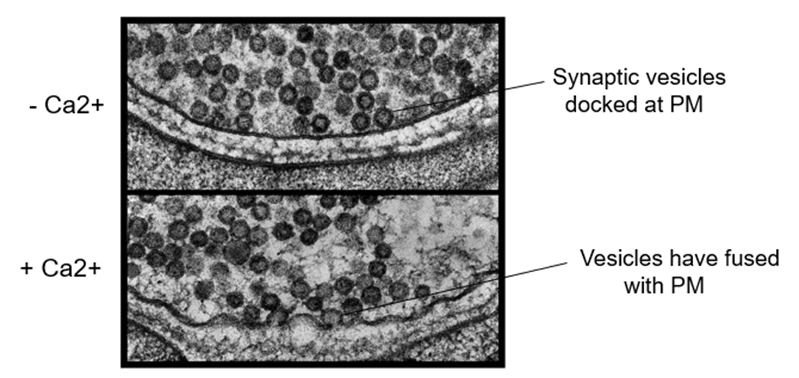
What is the structure of the trans-SNARE complex responsible for docking synaptic vesicles at the PM (EXTRA)?
The v-SNARE synaptobrevin and the t-SNARE syntaxin are both transmembrane proteins, and each contributes one α helix to the complex.
By contrast to other SNAREs discussed earlier, the t-SNARE SNAP25 is a peripheral membrane protein that contributes two α helices to the four-helix bundle; the two helices are connected by a loop (dashed line) that lies parallel to the membrane and has fatty acyl chains (not shown) attached to anchor it there.
4 helix bundle
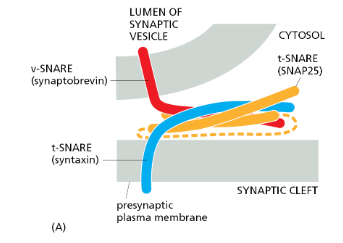
How can fusion of synaptic vesicles occur so rapidly?
At the synapse, the basic SNARE machinery is modulated by the Ca2+ sensor synaptotagmin and an additional protein called complexin. Synaptic vesicles first dock at the membrane
and the SNARE bundle partially assembles
resulting in a “primed vesicle” that is already drawn close to the membrane. The SNARE bundle assembles further, but the additional binding of complexin prevents fusion
Upon arrival of an action potential, Ca2+ enters the cell and binds to synaptotagmin, which releases the block and opens a fusion pore
Further rearrangements complete the fusion reaction and release the fusion machinery, which now can be reused.
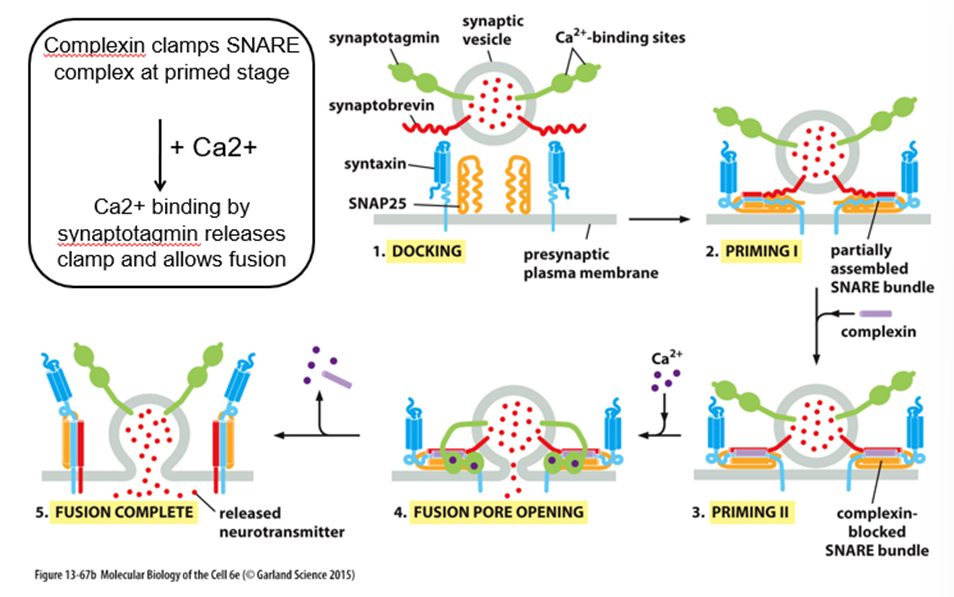
How can synaptic vesicles directly form from endocytic vesicles?
1.) Delivery of synaptic vesicle contents to PM
2.) Endocytosis of vesicle components to form new synaptic vesicle directly
3.) Endocytosis of vesicle components and delivery to endosome
4.) Budding of synaptic vesicle from endosome
5.) Loading of neurotransmitter into synaptic vesicle
6.) Secretion of neurotransmitter in response to action potential
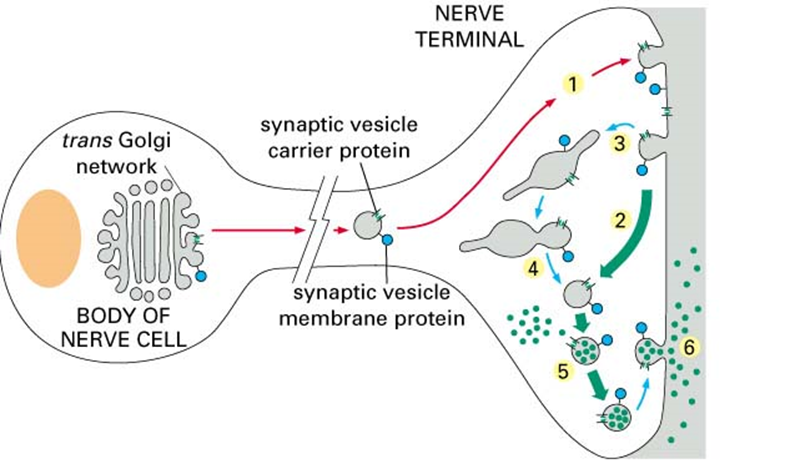
Why does this happen?
o Some nerves in the body as 1m long, if you have to make all neurotransmitters in cell body it will be a long way away and take a long time to get there
o Need to be able to load up synaptic vesicles at the nerve terminus
What happens post fusion?
Massive delivery of membrane to surface (e.g. pancreatic acinar cell (30x fold increase in S.A. upon stimulation)
Not ideal to maintain tissue structure
Membrane is rapidly internalised by endocytosis
Membrane pathways are typically BALANCED which ensures cells and organelles maintain a constant size
However in some cases want plasma membrane expansion
When do you want plasma membrane expansion and hpw does this happen?
Regulated exocytosis can promote plasma membrane expansion
The origin of exocytosed membrane not clear in all cases
In some cases may originate from classical secretory vesicles, in others from endosomes or secretory lysosomes
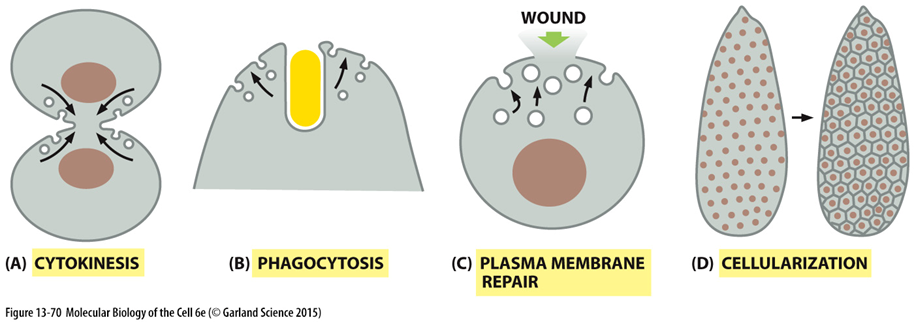
What is the structure of most cells in tissues?
Most cells in tissues are polarized, with two or more molecularly and functionally distinct plasma membrane domains
What is the structure of a polarised cell?
• 2 domains of PM: Apical and Basolateral
o Different proteins and functions
• Separated by molecular ‘fence’ (tight junction or axonal hillock)
• Different domains have distinct lipid and protein content
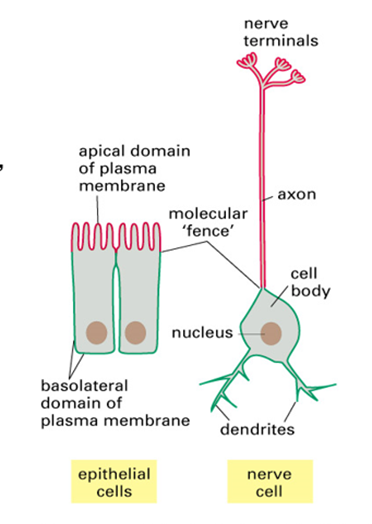
What do sorting signals do?
guide proteins to apical or basolateral membrane
Where do the cargo proteins get sorted?
Some cargo proteins that are destined for the apical membrane get sorted away from those destined for the basolateral membrane at the TGN
What are the 2 ways of sorting plasma membrane proteins in a polarised epithelial cell?
Direct pathway and indirect pathway

What is the direct pathway?
Proteins destined for different plasma membrane domains are sorted and packaged into different transport vesicles
What is the indirect pathway?
apical proteins first get delivered to basolateral membrane, then get reinternalized into endosomes and get transported across the cell to the apical membrane (transcytosis)
Some proteins that function at the apical membrane pick something up with the basolateral side first
Eg pick up a ligand if thy are a receptor
The indirect pathway, for example, is used in liver hepatocytes to deliver proteins to the apical domain that lines bile ducts.
What is the structure of most apical sides of epithelial cells (extra)?
greatly enriched in glycosphingolipids, which help protect this exposed surface from damage; for example, from the digestive enzymes and low pH in sites such as the gut or stomach
, plasma membrane proteins that are linked to the lipid bilayer by a glycosylphosphatidylinositol (GPI) anchor are found predominantly in the apical plasma membrane
What do secretory and GPI anchored proteins rely on?
While secretory and GPI-anchored proteins rely on the direct pathways, membrane proteins can sometimes use an indirect route to arrive at the appropriate membrane surface
In this route, both apical and basolateral cargo travel together in transport vesicles from the TGN to the basolateral membrane.
Membrane proteins that do not belong in that region of the plasma membrane are retrieved by endocytosis and are transported via early endosomes to the correct region.
Membrane proteins destined for delivery to the basolateral membrane contain sorting signals in their cytosolic tail.
When present in an appropriate structural context, these signals are recognized by coat proteins that package them into appropriate transport vesicles in the TGN. The same basolateral signals that are recognized in the TGN also function in early endosomes to redirect the proteins back to the basolateral plasma membrane after they have been endocytosed. A combination of direct and indirect deliveries ensures that the apical and basolateral membranes retain their distinct identities
KEY POINTS
